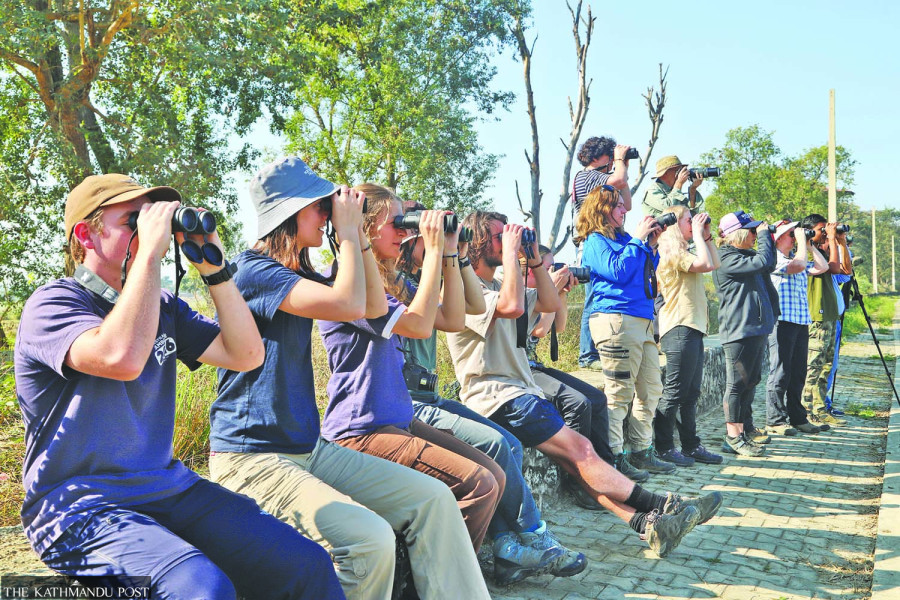Lumbini Province
Nepal’s biodiversity attracts foreign research students
Environmental Science students from an Australian university are in Nepal to study habitats, feeding habits and breeding of aquatic migratory birds.
Manoj Paudel
Peter Newbery, a retired medical doctor from Australia, is an avid birding enthusiast. Pursuing his passion, the 65-year-old retired doctor enrolled at Charles Sturt University in New South Wales, Australia to study Environmental Science.
What piqued Newbery’s interest most is the Oriental pratincole, a swallow species that migrates to the Indian subcontinent from Australia in the summer to breed. Newbery, accompanied by 11 Bachelor of Environmental Science students and Associate Professor Melanie Massero from the university, is now in Nepal to study the habitat of the Oriental pratincole alongside other aquatic bird species.
They landed in Nepal some three weeks ago to study birds, wildlife and biodiversity the country is home to. The team visited Jagadishpur lake in Kapilvastu to learn about the habitat of the migratory aquatic birds including Oriental pratincoles.
“I observed some wetlands near the Nepal-India border including Jagadishpur lake in Kapilvastu,” said Newbery. “Many of my queries about birds—mainly the habitats, foods and breeding environment—have been addressed after I visited various places in Nepal.”
Jagadishpur lake was declared a bird sanctuary, the country’s second, in July last year. The division forest office in Kapilvastu had started the due process to make Jagadishpur lake a bird sanctuary after some forest, environment and eco-tourism experts recommended that the lake is ideal to be remodelled as one.
According to conservationists, of the 891 species of birds found in Nepal, 167 species, including Oriental pratincole, grebes, cormorants, herons, egrets, stork, ducks and geese, terns and gulls, are found in the Jagadishpur lake. The lake provides shelter to 15,000 to 20,000 migratory birds that arrive from as far away as Siberia, China, Russia, Mongolia, Turkmenistan and Kyrgyzstan to spend the winter. The Australian team came to Jagadishpur lake to study aquatic birds.
Jagadishpur Lake was listed as a Ramsar wetland site in August 2003. The lake is spread over 157 hectares across Kapilvastu Municipality’s wards 9 and 10, and is located some 11 kilometres north of Taulihawa, the district headquarters.
According to senior ornithologist Hemsagar Baral, Oriental pratincoles are also found in Jagadishpur lake in summer but they do not breed in the lake area. Baral said that Oriental pratincoles breed in the Manohara river in Bhaktapur.
As part of their research, the Australian team is also focussing on the roles the locals living in close proximity to wildlife and birds play in conservation efforts.
The team visited Annapurna Conservation Area, Ghandruk, Lumbini and the wetlands in its vicinity before they reached Jagadishpur lake last week. “We are really impressed to see that the Nepali culture, ways of life and the religions practised here have kept the conservation and protection of wildlife as a cornerstone of worship,” said Helen Thompson, one of the university students. “Nepalis worship crows, dogs, snakes, tortoises and other birds and animals which creates a mechanism to protect them from harm. I feel like Nepal is a safe haven for wildlife and birds to thrive in.”
The university team is currently in Chitwan National Park and its buffer zone areas conducting their research.
The university administration says that it chose Nepal as its research focal centre for its varied biodiversity and natural beauty. “Nepal is truly an amazing nation. One can observe snow-clad mountain peaks of the Himalayas, green hills and southern plains. The entire country can successfully turn into a sanctuary for birds and wildlife given its biodiversity,” said Massero, who leads the research team.
Ashlee Barker, another student, added, “The natural beauty, biodiversity, birds and wildlife lured us to Nepal. Various works carried out in the conservation sector in the mountain, hill and Tarai regions in Nepal are laudable.”
Conservationists and tourism entrepreneurs say that the selection of Nepal for their studies and research by the students and researchers of reputed universities is very helpful in promoting ecotourism in the country. “After their thorough study, the visiting students will publish a research book and share their experience,” Baral said. “That research paper will provide useful information for Nepal to make conservation plans for the future. It will also be an effective publicity for Nepal to develop eco-tourism.”




 6.12°C Kathmandu
6.12°C Kathmandu















